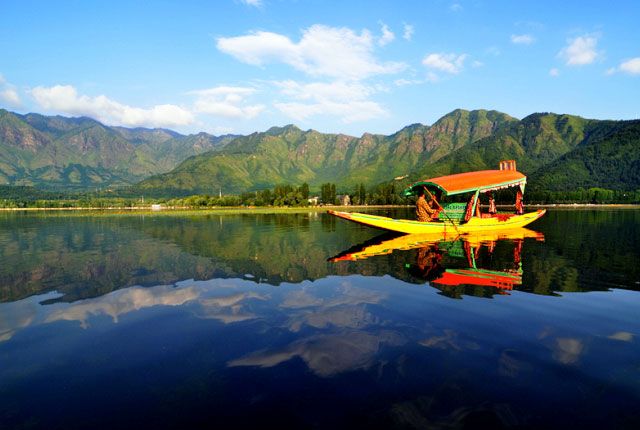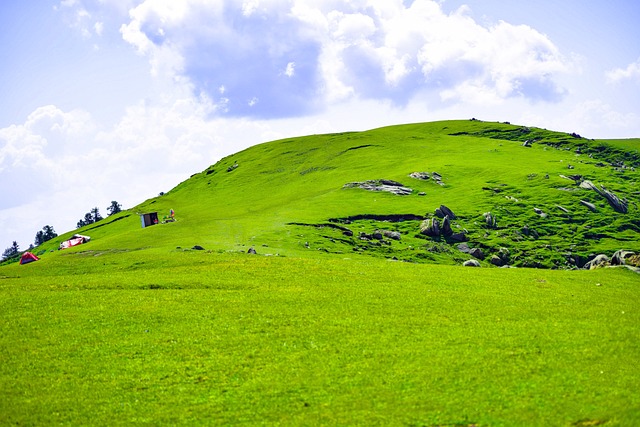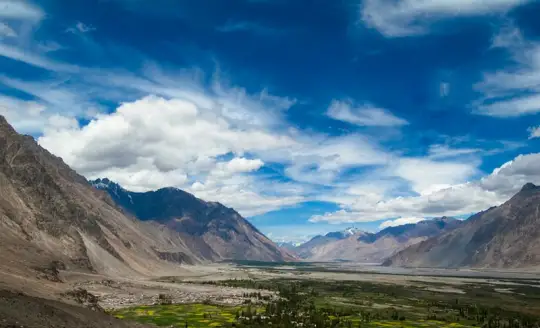
Nubra Valley, Ladakh : Nature’s Masterpiece
Table of Contents
ToggleOverview
Nubra Valley, a strikingly beautiful and secluded region in the northeastern part of Ladakh, attracts visitors from different parts of the world because of its tranquil charm and rich cultural heritage. With an elevation surpassing 3,000 meters, this valley is popularly known as the \”Valley of Flowers” and caters to a unique blend of nature, adventure, and spirituality. Nubra Valley is a place which Nature lovers, adventure seekers and even culture vultures will equally appreciate. In this blog, we explain in detail why Nubra Valley is a uniquely beautiful place that stands head above shoulders from the rest, its peculiar attributes, must visit places, and travel hacks for the upcoming tourists.
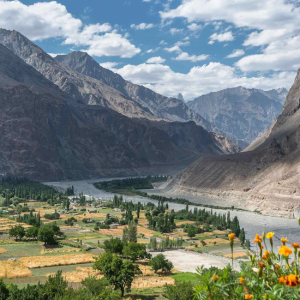
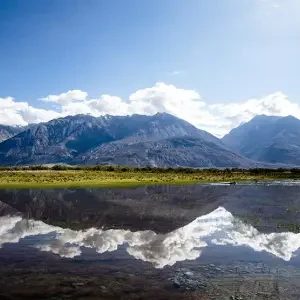
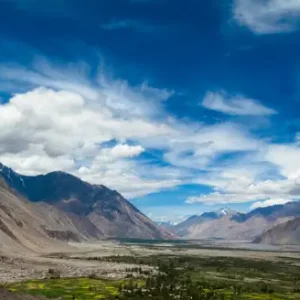
What Makes Nubra Valley Exceptional?
Geographical Wonders: A One Of a Kind Landscape
Nubra Valley is renowned for its aesthetic beauty and breathtaking landscape. This valley is encompassed by colossal mountains, sparkling sand dunes, and rivers that nurture this arid region. The Nubra Valley is divided into two parts by the Shyok and Nubra Rivers, and its topography ranges from green fertile oases to dry, rocky, desert-like expanses. Travelers can experience the combination of snow capped mountains, sand dunes, and blue water, making Nubra Valley one of the most beautiful sights in Ladakh.
Trekking through the valleys of Nubra Valley, one witnesses shifting landscapes ranging from calm meadows to rugged deserts, ideal for landscape photography. The valley is home to diverse fauna and flora, with some species surviving in this harsh high-altitude desert. The cliffs covered in white snow, combined with the sand dunes further add to nature’s beauty.
Cultural Diversity
As if the picturesque landscapes weren’t enough, Nubra Valley has some deep-rooted Tibetan Buddhist history and culture. Several ancient monasteries are located in the valley and provide insight into Ladakh’s spiritual past. The calmness of these temples alongside the mountains serve as a destination for meditation and self-reflection.
Buddhist population predominantly makes up the population in Nubra Valley. Lakad and Tibetan cultures blend seamlessly and enrich the region. Local markets and unique handicrafts serve as a great celebration for many of the region’s well loved festivals. The perfect fusion of nature, history and culture give Nubra Valley a truly distinct identity unlike any other region in Ladakh.
Accessibility and Climate
Nubra Valley is not particularly difficult to get to, and although many places have not been affected by mass tourism, it is still frequently visited. Travelers using Khardung La Pass are met with stunning views of the barren landscapes, as the valley is 150 kilometers away from Leh and the Kyhardung Pass is one of the highest motorable roads in the world. Thus, the journey is memorable due to the mountains and the unique road.
Traveling to Nubra Valley is feasible year round, as snowfall does occur, making the valley even more mesmerizing; however, this does pose some issues when attempting to travel. Snowfall during the winter months often turns the valley into a magical haven, though means of travel suffer as a consequence. Winters (October to March) are also incredibly harsh, often going below freezing, whilst being surrounded by snow. The combination of these factors creates a cold desert climate, along with freezing winter and hot summer months. The best time to visit the valley is during summer, which ranges from May to September, and reaches a temperature of 30°C. Nights, while still cold, are incredibly pleasant across the entire region.
Best Time to Visit Nubra Valley
The best period to go to Nubra Valley is in summer from May to September. During this time, the weather is good for outdoor activities and sightseeing. However, this also happens to be the peak tourist season and the most crowded periods, including traffic jams at the main attractions.
If you’re looking for a less crowded experience, late September to early October is best for you. While the temperature begins to drop, the fall colors paired with these landscapes is breath taking. If you decide to travel during winter, be prepared for harsh cold temperatures and terrible road conditions.
Top Attractions in Nubra Valley
- Diskit Monastery
Diskit Monastery is the first and foremost landmark of Nubra Valley. This is the oldest, the largest and the most beautiful monastery built in the 14th century. The monastery is located on the top of a hill and is famous for its spectacular view of the mountains. Diskit contains beautiful murals, scripture tablets from the ancient past, and towering statue of Maitreya Buddha that symbolizes peace and prosperity for the valley.
Visitors to Diskit Monastery can enjoy the rich culture of the place by visiting the prayer halls, conversing with the monks, and appreciating the tranquil environment. Undoubtedly, the views from the monastery, accompanied by surrounding mountains and valleys, are astounding, especially at sunrise or sunset.
- Hunder Sand Dunes and Camel Ride
One of the most remarkable experiences in Nubra Valley is the opportunity to be on a double humped Bactrian camel and riding it through the famous sand dunes of Hunder. This small village is renowned for its desert-like topography, and seeing camels stroll through sand dunes with the snow capped peaks behind them is something one can only imagine. Camel rides are one of the best things to do in Nubra, and they offer a chance to experience the remarkable desert regions of Nubra Valley in a unique way.
These Hunder Sand Dunes are also one of the best places for nature photographers as they offer everything from barren sand dunes to rich green patches of vegetation.
- Turtuk Village
For those looking to delve deeper into Ladakh’s heritage, Turtuk offers a different experience altogether. This remote village lying in the far north of Nubra Valley is a must visit. Before the 1971 war, it was part of Pakistan and till now boasts a distinct Balti culture. The village is located amid steep mountains and hosts its own indigenous customs, cuisine, and way of life. Guests to Turtuk can look forward to exploring traditional wooden homes, local Balti temples, and the hospitality of its friendly residents. Turtuk’s rich green fields and orchards strikingly differ from the barren landscapes of the rest of the Nubra Valley, contributing to its charm as a quiet, untouched location.
- Sumur Monastery
Alongside Diskit is the township of Sumur where this monastery is located. Sumur Monastery is one of the more popular religious sites of Nubra Valley and is also known for its calm surroundings together with the stunning views. The Sumur Monastery is inhabited by a few monks of the Tibetan Buddhist sect. The calm surrounding here is perfect for meditation and other religious activities such as attending prayer services and learning the philosophies of Buddhism.
The surrounding mountains and the gardens of the monastery are a beautiful sight for plenty of tourists looking to unwind and get some fresh air.
- Panamik Hot Springs
The Panamik Hot Springs are a breathtaking sight, making them a must see location in the region. Located in Panamik village, this natural sulfur spring is known for its medicinal properties. Soaking in these hot springs is believed to be beneficial for joint pains and skin conditions. After a long day of exploring the sights, the warm waters of the spring make for a relaxing experience, especially when combined with the beautiful environment.
Adventure Activities in Nubra Valley
- Trekking and Hiking
For adventure lovers, Nubra valley is a place to rejoice due to the countless trekking options the valley provides. Most famous treks at Nubra Valley includes the Nubra Valley Trek which takes you through isolated villages, monasteries and bountiful nature. This trek is ideal for people wanting to lose themselves in nature and unseen parts of the valley.
Another famous trek is the Markha Valley Trek. It begins from Leh and goes from Nubra Valley. It is known for its rough tracks, high mountain passes and astonishing views of the Himalayas.
- Mountain Biking
Nubra Valley is suitable for mountain biking, as the valley provides challenging terrains for mountain bikers. The rugged roads and diverse landscapes of the region are well suited for experienced bikers. From the high altitude roads of Khardung La, to the sand dunes of Hunder, cycling in Nubra Valley is an experience of a lifetime.
- Photography
The scenic beauty of Nubra Valley provides diverse photography subjects which include snow-capped peaks, beautiful valleys, ancient monasteries, and the local life. Whether an amateur or a profession photographer, the breathtaking views of Nubra Valley are bound to provide the required inspiration. The region is even more photogenic during the sunrise and sunset, as the light changes and the magic makes the photographs more appealing.
How to Reach Nubra Valley
Nubra Valley is easily accessible from Leh, the main town in Ladakh. Leh can be accessed by air or road, and Nubra Valley can be reached from Leh via Khardung La Pass. The pass is accessible throughout the summer months and may get closed during winter due to heavy snow fall.
The ride from Leh to Nubra Valley covers a distance of 5-6 hours and features beautiful views of the Ladakh mountain range. Additionally, it passes through a few villages and monasteries which adds a cultural aspect to the venture.
Travel Tips for Nubra Valley
- Acclimatization: Nubra Valley’s altitude is very high, which means that travelers need to spend a few days acclimatizing to the change in altitude. Avoiding altitude sickness can be achieved by staying a day or two in Leh at first.
- Clothing: The weather in Nubra Valley can change without any prior notice. Even in summers, warm clothing is essential for the night and evenings.
- Permits: Those wishing to visit Panamik or Turtuk would need to acquire a Protected Area Permit (PAP). Be sure to arrange these permits well in advance for a hassle free experience.
- Stay Hydrated: The weather’s cold and dry nature means that it can quickly lead to dehydration. It is important to stay hydrated, which means carrying enough water during the trip.
Conclusion
Nubra Valley is a unique destination with stunning views that provides travelers a once in a life time experience. It’s landscapes along with cultural assets make it one of the most fascinating places in Ladakh. No matter if you are a lone adventurer or someone looking for peace and nature, Nubra Valley won’t disappoint you. Take the time to plan your visit and this hidden treasure will serve as your lifetime memento.
How to book Ladakh tour?
Contact a travel agency that specializes in Kashmir tours. You can reach out to the following for assistance:
- Phone:
- +91 7889 655596
- +91 7006 891267
- Email:
Inquire about tour packages, itineraries, and pricing, and confirm your booking for a memorable winter experience!
People Also Ask
What is Nubra Valley known for?
Nubra Valley, located in Ladakh, is famous for its unique landscapes, the Nubra River, sand dunes, and the famous Bactrian camels. It is also known for its monasteries, scenic villages, and high-altitude desert terrain.
How do I reach Nubra Valley from Leh?
The most common way to reach Nubra Valley from Leh is by road. You can travel through the Khardung La Pass, one of the highest motorable roads in the world. The journey takes about 4-5 hours, depending on road conditions.
When is the best time to visit Nubra Valley?
The best time to visit Nubra Valley is between May and September, when the weather is mild, and the roads are open. Winter months (November to March) can be very cold, with heavy snowfall blocking roads.
What is the landscape of Nubra Valley like?
Nubra Valley features a diverse landscape, including vast sand dunes, lush green oases, high-altitude desert terrain, and snow-capped mountains. It is an oasis in the middle of a rugged and arid environment.
What are the top attractions in Nubra Valley?
Top attractions in Nubra Valley include the Khardung La Pass, Hunder Sand Dunes, Diskit Monastery, Panamik Hot Springs, and the villages of Turtuk and Sumur. Visitors can also take camel rides on Bactrian camels.
Is Nubra Valley safe for tourists?
Yes, Nubra Valley is generally safe for tourists. However, since it’s located at high altitudes, acclimatization is important to avoid altitude sickness. Travel with a guide or as part of a tour group to ensure safety.
Can I ride a Bactrian camel in Nubra Valley?
Yes, Bactrian camels are a popular attraction in Nubra Valley. You can enjoy a camel ride in the sand dunes of Hunder, which offers a unique desert experience with the backdrop of snow-capped mountains.
What is the Khardung La Pass?
Khardung La Pass is one of the highest motorable roads in the world, located at an altitude of 5,359 meters (17,582 feet). It connects Leh to Nubra Valley and offers stunning views of the surrounding mountains.
How can I get an Inner Line Permit for Nubra Valley?
An Inner Line Permit (ILP) is required to visit Nubra Valley, as it is a protected area. You can obtain the permit from the Leh DC office or through a travel agency. The ILP is usually valid for 7 days.
What is the climate like in Nubra Valley?
Nubra Valley has a cold desert climate with harsh winters and mild summers. Summers are pleasant, with temperatures ranging between 15°C to 25°C, while winters can be freezing with temperatures dropping to -20°C.
Are there any monasteries in Nubra Valley?
Yes, Nubra Valley is home to several monasteries, including the Diskit Monastery (the oldest and largest in the valley), Sumur Monastery, and the Panamik Monastery. These monasteries offer a peaceful and spiritual atmosphere.
What activities can I do in Nubra Valley?
Popular activities in Nubra Valley include camel rides on the sand dunes, trekking, visiting monasteries, exploring villages like Turtuk and Sumur, and taking a dip in the Panamik Hot Springs. The valley is also great for photography.
What is the significance of the Diskit Monastery?
Diskit Monastery, located in the Nubra Valley, is one of the most important monasteries in Ladakh. It is known for its large statue of Maitreya Buddha, offering panoramic views of the surrounding landscape.
How long does it take to reach Nubra Valley from Leh?
The drive from Leh to Nubra Valley takes approximately 4-5 hours, covering a distance of around 120 kilometers, depending on road conditions and the number of stops along the way.
Can I visit Nubra Valley in winter?
Yes, you can visit Nubra Valley in winter, but the weather can be extremely cold and challenging. The roads might be blocked due to snow, and some accommodations may be closed. It’s best suited for adventure travelers and those prepared for cold conditions.
Are there accommodations in Nubra Valley?
Yes, there are several guesthouses, camps, and homestays in Nubra Valley, especially in the main towns of Diskit and Hunder. Luxury camps and eco-friendly accommodations are also available for tourists looking for unique stays.
How is the road condition from Leh to Nubra Valley?
The road from Leh to Nubra Valley is generally in good condition, although it can be bumpy and winding in certain sections. The Khardung La Pass, which is part of the route, can experience extreme weather conditions, so check road updates before traveling.
What is the significance of the village of Turtuk?
Turtuk is a unique village in Nubra Valley, known for its Balti culture and proximity to the Pakistan border. It offers a glimpse into a distinct way of life, with lush greenery, traditional houses, and a fascinating history.
What should I pack for a trip to Nubra Valley?
Essential items to pack for Nubra Valley include warm clothing (even in summer), sunscreen, a good camera, comfortable trekking shoes, and a hat or scarf to protect yourself from the sun. Don’t forget your Inner Line Permit and essential medicines.
Can I visit Nubra Valley on a motorcycle?
Yes, Nubra Valley is a popular destination for motorcyclists. Many travelers ride from Leh to Nubra Valley, enjoying the thrilling ride through Khardung La Pass and the scenic landscapes along the way.
What are the health precautions before visiting Nubra Valley?
Due to the high altitude, it’s important to acclimatize properly to avoid altitude sickness. Stay hydrated, take it easy during the first couple of days, and avoid heavy exertion. Carry any necessary medications and a first-aid kit.
What is the best way to explore Nubra Valley?
The best way to explore Nubra Valley is by hiring a local guide or joining an organized tour. This allows you to learn about the region’s culture and history while ensuring a safe and enjoyable experience. You can also explore by car or motorcycle.
Are there any hot springs in Nubra Valley?
Yes, the Panamik Hot Springs, located in the northern part of Nubra Valley, are famous for their therapeutic properties. Visitors can take a dip in the natural sulfur-rich waters, which are believed to have healing benefits.
What wildlife can be found in Nubra Valley?
Nubra Valley is home to a variety of wildlife, including the Tibetan wild ass (kiang), snow leopards, marmots, and several species of birds like the golden eagle and Himalayan griffon vulture. It’s also part of the Nubra Valley Wildlife Sanctuary.
Can I trek in Nubra Valley?
Yes, there are several trekking routes in Nubra Valley, including the trek to the Nubra River, the trek to Turtuk, and longer treks that connect Nubra with other regions of Ladakh. These treks offer stunning views and an adventurous experience.
Are there any local festivals in Nubra Valley?
Yes, Nubra Valley hosts several local festivals, including the Diskit Monastery Festival, which is celebrated with traditional dances, music, and prayers. Other Ladakhi festivals are also observed in the valley, offering a glimpse into the region’s rich cultural heritage.
Can I do photography in Nubra Valley?
Yes, Nubra Valley offers fantastic opportunities for photography, from the sand dunes and Bactrian camels in Hunder to the stunning views of snow-capped mountains, monasteries, and the picturesque villages of Turtuk and Sumur.
Is there internet access in Nubra Valley?
Internet access in Nubra Valley is limited and can be unreliable, especially in remote areas. Some guesthouses and cafes may offer Wi-Fi, but expect slow speeds and intermittent connectivity.
What makes Nubra Valley unique?
Nubra Valley is unique due to its combination of a high-altitude desert, rich cultural heritage, and natural beauty. The valley’s sand dunes, Bactrian camels, ancient monasteries, and traditional villages set it apart as one of Ladakh’s most intriguing destinations.



